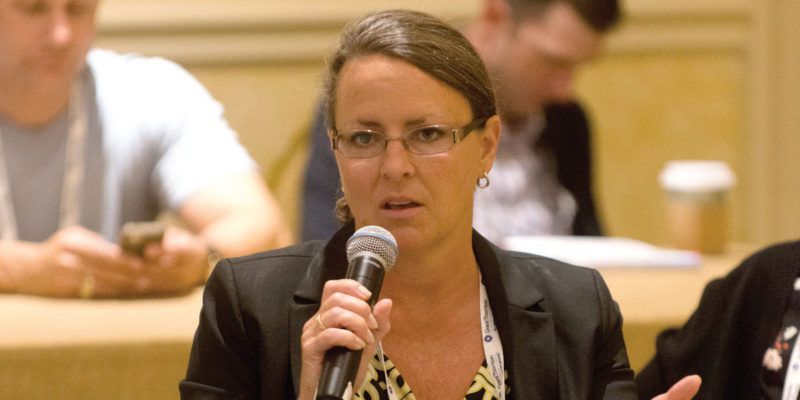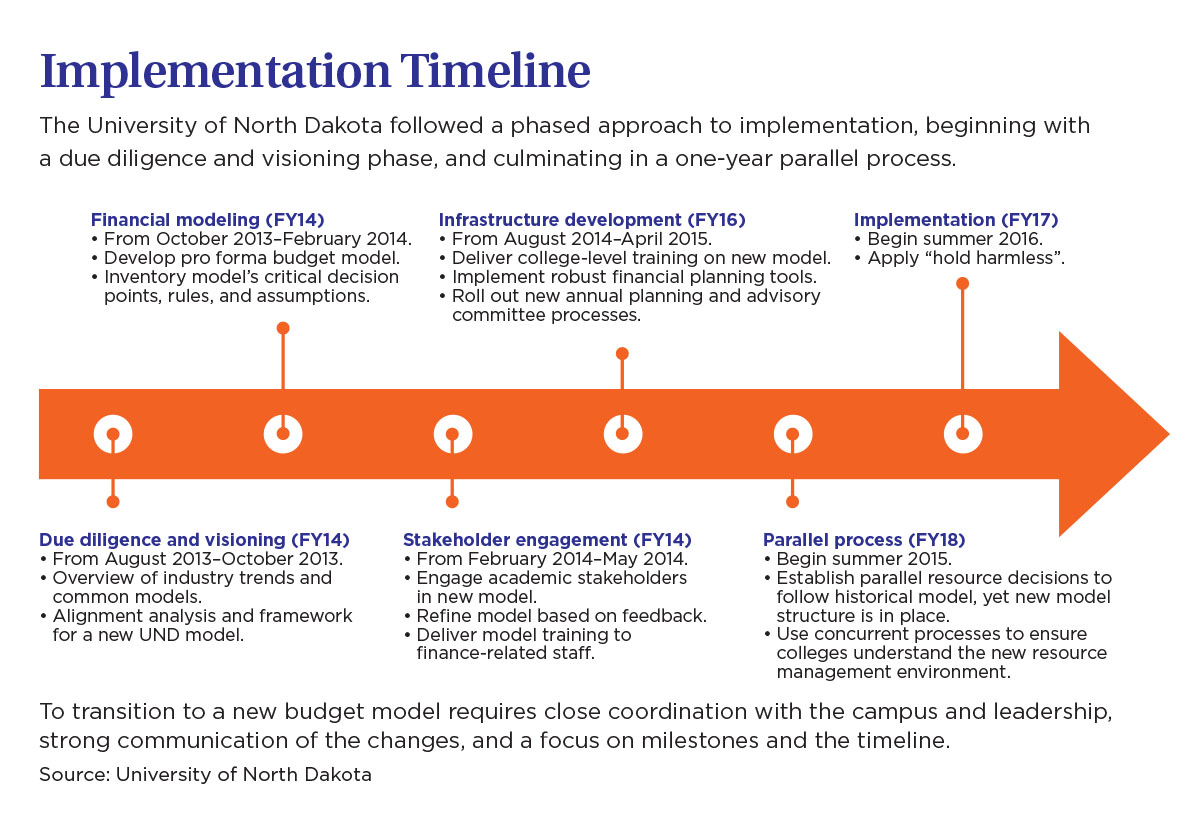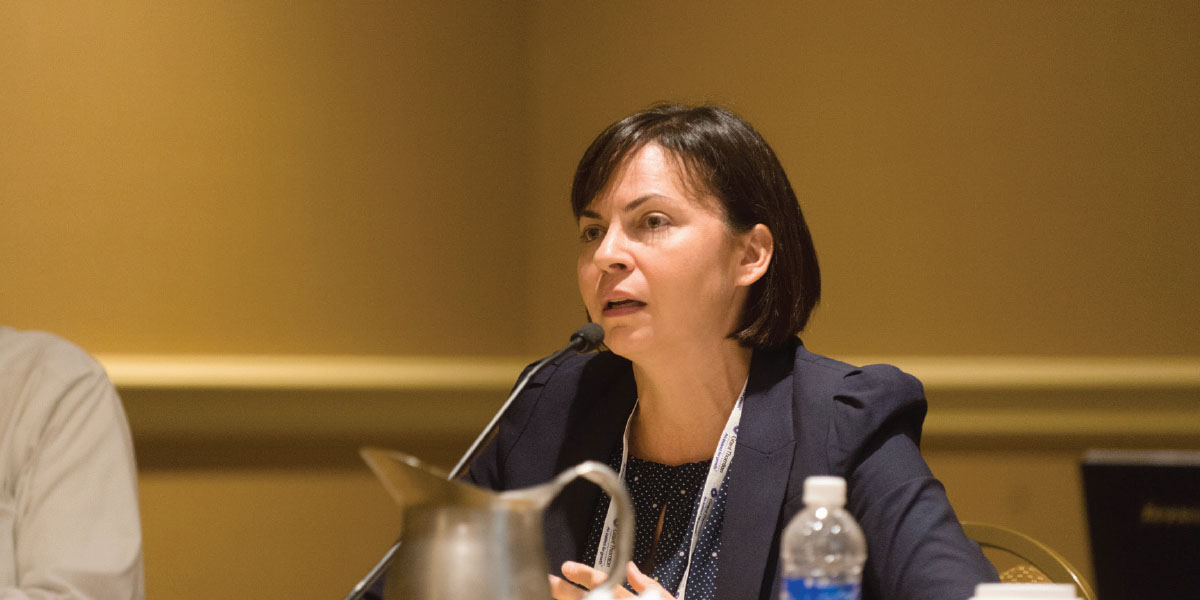
Engaging Stakeholders in Budget Redesign

In an effort to grow revenue and increase transparency about financial management, the University of North Dakota (UND) built an incentive-based budget model, which balanced its need for central flexibility with the entrepreneurial benefits of local decision making.
“When it comes to budget models, there’s no one-size-fits-all approach,” said Thomas DiLorenzo, provost and vice president, academic affairs. DiLorenzo, the UND president, and the chief business officer embraced the move from an incremental budget model to an incentive-based model in 2013. The institution brought in Huron Consulting as a project partner to ensure that all the right questions and issues were considered.

A Team Effort
At the session “Engaging Stakeholders in Redesigning the Budget Model,” DiLorenzo co-presented with CBO Alice Brekke where they focused on the key elements of their new budget model implementation (see figure, “Implementation Timeline”). Andrew Laws, managing director of Huron Consulting Group, rounded out the panel to offer budgeting model trends among various institutions with which Huron has worked.

Brekke and DiLorenzo emphasized that their success was dependent upon UND President Robert O. Kelley’s support for redesigning the budget model from the very beginning, and him being a visible advocate throughout the implementation. Also, every dean was supportive, which was absolutely critical to the redesign.
They recommended the following tips to those attempting a similar change:
- Be selective and intentional when appointing a steering committee, and include individuals who are certain to communicate and collect information informally as well as formally.
- Don’t underestimate the amount of ongoing communication, education, and training required to implement the change.
- Employ a long-term (3–5 years) budgetary outlook.
- Allow approximately 2.5 years for the process, beginning with due diligence and visioning, and culminating in a one-year parallel process.
MARYANN TERRANA is director, member engagement, at NACUBO.
A New Model Rolls Back Tuition, Increases Revenue and Affordability

How Millersville University, Millersville, Pa., found a way to maintain affordability while increasing revenue was the focus of the session “From Flat Rate to Per-Credit Tuition.” Roger Bruszewski, vice president, finance and administration; Lois Johnson, associate vice chancellor, administration and finance; and Jennifer Mariacher, budget director, said their solution was to move from charging undergraduate in-state students a flat rate for tuition to charging them per-credit hour.
Not only would the per-credit option include increased revenue, it would also change student behavior as it relates to course selection, and increase winter and summer sessions course enrollments while decreasing the number of credits received for graduation.
The model required approval from the board of governors and the council of trustees, along with annual reporting. It allows a 7 percent rollback of per-credit tuition from the 2014–15 rate used by the Pennsylvania State System of Higher Education and increases financial aid up to $1.1 million per year to assist students with the greatest need. During the first three years of the program, which was implemented in 2014, Millersville tuition will be slightly lower than the system rate; however, by the 2017–18 academic year, the two will be the same.
Changes Bring Positive Results
The institution used a three-step implementation process: identifying a team that would work on the model; developing a communications plan; and finding out the areas that would be affected by this program. Key internal implementation challenges included financial aid packaging, delayed refunds, tuition payment plans, and assessing fees and waivers. Other programs that were affected included the tuition assistance programs, 529 savings plan, the tuition management plan, PHEAA state grant program, and the student exchange programs.
Between fall 2013–15, Millersville sent fewer past-due bill statements and as a result, the per-credit hour billing helped with receiving payments on time. In winter 2014, there was a 15 percent increase in tuition revenue; total revenue generated was $3.9 million.
KHESIA TAYLOR is associate editor of Business Officer.
It’s About Whole Health

Good health and well-being, says Kevin Kruger, are critical to student retention, academic success, and degree attainment.
In the featured session “Mental Health Issues: Reducing Risks for Students and Campuses,” Kevin Kruger, president of NASPA: Student Affairs Administrators in Higher Education, framed this topic in terms of student retention and persistence.
Typical triggers of student depression may include the death of a family member or a friend, divorce of parents, personal or family illness, homesickness, anxiety about an academic major or career path, fears about graduation, or financial worries. Layer on top of those factors potential incidents of sexual assault or other gender-based violence, or alcohol or drug abuse and it becomes clear that college students today face myriad pressures and distractions from their role as students, Kruger said.
In addition, more first-generation and low-income students are attending college today, and these students may not have the same understanding of campus services, are more likely to experience financial stress, and probably have a less robust family support structure in place, he said. And, today’s increasingly online generation of students potentially faces an increased sense of isolation.
What Institutions Can Do
The stress from any one of this complex set of pressures can lead to depression when people wait too long to seek help, and this can adversely impact academic performance. “Students spend less time studying or begin skipping classes and then suddenly they fall behind and eventually may drop out,” Kruger said. “The reality is that student health and well-being are critical to student retention, academic success, and degree attainment.” Any touch point for a student experiencing even low levels of stress may prove essential in keeping a student enrolled and on track to persist to degree completion, he added.
Kruger noted that higher education leaders would be wise to think about and address student mental health not as an isolated concern, but as a complex set of factors requiring a multifaceted response. “Bottom line, many students with pressing mental health concerns simply will not graduate without our help.”
Given the scope and interconnection of these student mental health issues, how can institutions best respond? There are some evidenced-based approaches that appear to be working and that more campuses are employing, Kruger said.
- Better faculty and staff training can help pick up on early warning signals. Many times the signals emerge in a student’s academic performance, with missed attendance and missed deadlines, which is why faculty play a key role in a larger intervention strategy, Kruger explained. Structured care teams composed of a diverse collection of campus personnel can provide a coordinated prevention response.
- Some institutions are combining services for counseling with health and wellness centers, not only for administrative efficiencies, but also for service efficiencies. If a student comes in reporting a health concern such as the flu or sleeping problems, a health representative can inquire about what is happening with the student, and this can provide opportunities for a student to identify areas of stress he or she may be experiencing. Health and wellness coaching as an added service can also help remove the stigma of students self-reporting a problem.
- The amount of time students must wait to have a health matter addressed is another critical factor in appropriate response, since the severity of an issue usually only escalates the longer it continues without resolution. For most institutions, staffing ratios remain a challenge as do budgetary commitments to student mental health. Some innovations on the technology front such as therapist-assisted online services—though not without controversy—do hold promise for freeing on-site counselors to address more severe cases, Kruger said.
- Anything that provides opportunities for personal interaction can also contribute positively to student mental health and to retention and completion. In a day when social and academic interaction have migrated so substantially to online venues, providing physical spaces for students to engage with others in person can provide a lifeline for those suffering from loneliness and isolation.
“Because no institution will ever be able to hire enough counselors, a coordinated prevention strategy is in order to help students well before the point of crisis,” Kruger said.
KARLA HIGNITE is a contributing editor for Business Officer.
Creating Your Personal Executive Brand

During the lunch keynote address of the Future Business Officers Program, Kimberly Pace shared tips for developing an executive personal brand. “Who you think you are and how others perceive you as a leader aren’t always in perfect alignment,” said Pace, professor of the practice of management, Owen Graduate School of Management, Vanderbilt University, and chief executive officer of Executive Aura LLC.
Pace asked the participants: When it comes to communicating to others who you are, what three adjectives would you like them to offer from their observations?
One suggestion she gave to them was to ask someone they didn’t know well to Google them and provide feedback about what they saw. “Some of you have pictures posted in your profiles where you don’t look happy to be alive,” she cautioned.
Handling Perceptions
When it comes to building a personal brand, what you convey about yourself is crucial, Pace said. Yet, what you actually say constitutes only a small percentage (7 percent) of your total message. Your tone of voice accounts for another 38 percent. (If you are sharing positive news, does your voice sound happy or flat?) The remaining 55 percent of someone’s perception of you is based on your body language—how you enter a room, what you do with your arms when you sit down, and how you shake hands. “For better or worse, sometimes these very small gestures are what shape someone’s perception of you,” Pace said.
Thankfully, this first impression doesn’t have to be the final word on your perceived character, she said. Consider these three phases of brand development:
1. Pre-presence. Before others meet you face-to-face, what might influence their opinion of you? Your e-mail and phone communication is one prime example of how you can shape an impression.
2. Presence. When you meet others face-to-face, do you present yourself in a manner consistent with how you want them to perceive you?
3. Post-presence. Once you leave an initial encounter, what does your follow-up communication suggest or reinforce about your character?
Sometimes what you don’t say can also leave a lasting impression, Pace said. Are you a good listener? Ultimately, your brand evolves from authenticity—how what you say and do matches with how you present yourself. And the most effective leaders exude a healthy balance of confidence and humility.
KARLA HIGNITE is a contributing editor for Business Officer.



